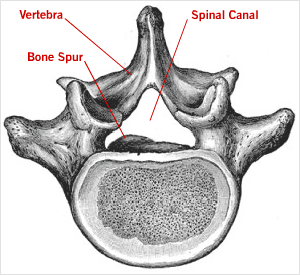 Ruptured disc, spinal stenosis or degenerating spinal joints? See three common and chronic spine problems. (Graphic: NPR)
Ruptured disc, spinal stenosis or degenerating spinal joints? See three common and chronic spine problems. (Graphic: NPR)
Too many complex back surgeries are being done and people are suffering as a result, according to a study in the current issue of the Journal of the American Medical Association. The general tendency noted in the study – that many patients and doctors think more medical care is always better – has implications for the new health overhaul law.
Back pain associated with aging can be treated in one of numerous ways: rest and physical therapy, surgery to remove the bony growths that can push on nerves, fusing two vertebrae together, or fusing many vertebrae together.
In the past few years, several studies have failed to show a big advantage for surgery – especially for complex surgery. Researchers from Oregon Health and Science University and several other places looked at Medicare billing records to see whether the rates or type of back surgeries went down as a result.
They found the number of surgeries has gone down very slightly. But when they looked specifically at complex surgeries, they found a big difference.
“The most complex type of back surgery has increased dramatically between 2002 and 2007, with a 15-fold increase,” says co-author Richard Deyo. In 2002, the rate of complex surgery was 1.4 per 100,000 people in Medicare. It jumped to 19.9 per 100,000 just five years later.
Related Audio
Deyo and his colleagues also checked the rate of complications. “This more complex form of surgery is associated with a higher risk of life threatening complications,” he says. Among people who just had the bony growths removed (a surgery called decompression), 2.3 percent had problems associated with their treatment, such as a heart attack, stroke or pneumonia. The complication rate was 5.6 percent among people who had multiple vertebrae fused together.
Deyo says there’s no reason to think people suddenly started developing the spinal deformities that justify the complex surgeries. He offers several possibilities for the upswing. “Many surgeons genuinely believe that the more invasive procedures offer some benefits,” he says. “But certainly there are important financial incentives at play as well.” Surgical fees for simple decompressions are about $600 to $1,000. The complex surgeries earn surgeons as much as 10 times more. He says another possible factor is the tendency for both doctors and patients to go for a new, more expensive approach just because it sounds better.
Orthopedist Eugene Carragee, a professor at Stanford University School of Medicine, wrote an editorial accompanying the research, saying that financial incentives are part of the problem. There’s also a problem with how new technologies are introduced, he says. In surgery, someone can just introduce a new procedure.
“The burden of proof in the system as it is now is that researchers have to go out to try and prove that what this guy wants to do doesn’t work, and that’s a backwards kind of thinking,” he says.
It’s far better to have to prove that something works before it becomes common practice, he says.
JAMA study researcher Deyo would like his study to alter the practice of medicine. “The effect I would hope it would have is to have surgeons and patients choose the least invasive procedure that would accomplish the surgical aim,” he says. But he’s pessimistic about it, unless there’s a change in the financial incentives.
James Weinstein is also calling for a rejiggering of financial incentives. Weinstein is an orthopedic surgeon and the director of the Dartmouth Institute for Health Policy and Clinical Practice. He did some of the original studies showing that most back surgeries make a minimal difference, if any. He says Deyo’s study shows one thing clearly. “The practice of medicine doesn’t always follow the best evidence,” he says.
The new health overhaul law sets up a new institute that would do studies like Deyo’s, comparing the risks and benefits of various treatments for various conditions. The law explicitly says the information can’t be used by insurers or government to set reimbursement policies, but Weinstein says the institute could make a big difference.
“I think if patients were well informed, they would choose the right thing,” Weinstein says. “We’ve done lots of studies with shared decision-making. Where patients are given good information they generally choose the least invasive, less risky procedure.”
He says health overhaul plans need to go beyond what’s in the new law. “Right now we have health insurance reform,” he says. “We need health care delivery reform, we need to change how we’re delivering practice and how we’re reimbursing for it.” What he’d like to see is a system that pays doctors and hospitals based on overall patient care, not separately for individual procedures.






